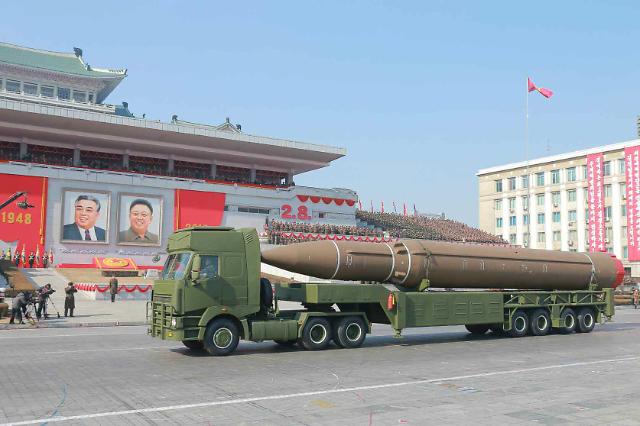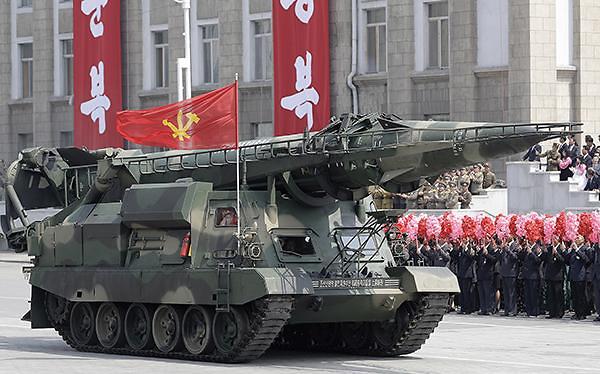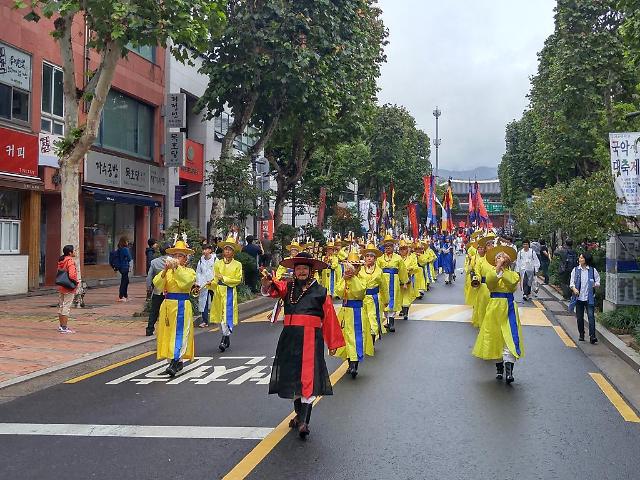
Joseon Dynasty honor guards lead a re-enacted royal parade near a palace in Seoul on October 8. [Photo and video by Park Sae-jin ]
A colorful royal parade was reenacted Saturday in South Korea, covering the length of an Olympic marathon and showing a variety of traditional folk art performances, a military counter-raid drill, and an iconic river-crossing event on a makeshift bridge made of wooden boats.
The two-day procession spanning a total of 42 kilometers (26 miles) started from Changdeok Palace in central Seoul, led by a traditional marching band, after a group of scouts armed with bows and arrows cleared the road ahead.
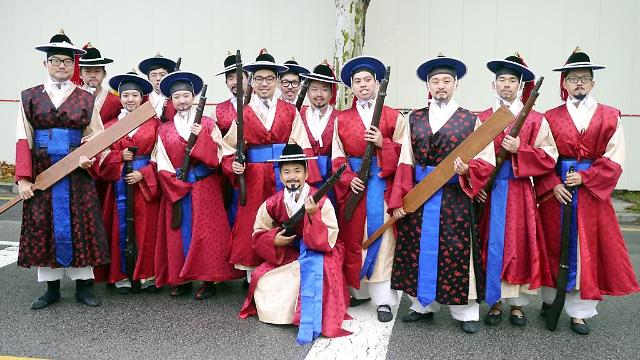
Volunteers wearing Joseon Dynasty royal honor guards pose for a photo shoot. [Photo by Park Sae-jin]
Palace guards and servants marched ahead of a royal carriage carrying King Jeongjo, the 22nd monarch of the Joseon Dynasty (1392-1897). It took more than 20 minutes for the whole procession to pass along a street.
"The sound of the parade's marching band called me out of my home. It's a pleasant surprise and I feel like as if I took a ride on a time machine," said Kim Hwa-seon, a 34-year-old housewife living near the palace.
The parade will finish at Hawseong Fortress, a UNESCO-designated cultural heritage site, built by Jeongjo (1752-1800) who had led solemn and lavish parades occasionally to the tomb of his father during his 24-year reign, accompanied by arriere-ban.
The pilgrimage has been reenacted every year from 2007 to celebrate the history of Jeongjo and his filial piety, a value which is still highly revered in South Korea. Organizers said this year's parade involving about 3,000 people and more than 300 horses was the largest and longest ever to be held.
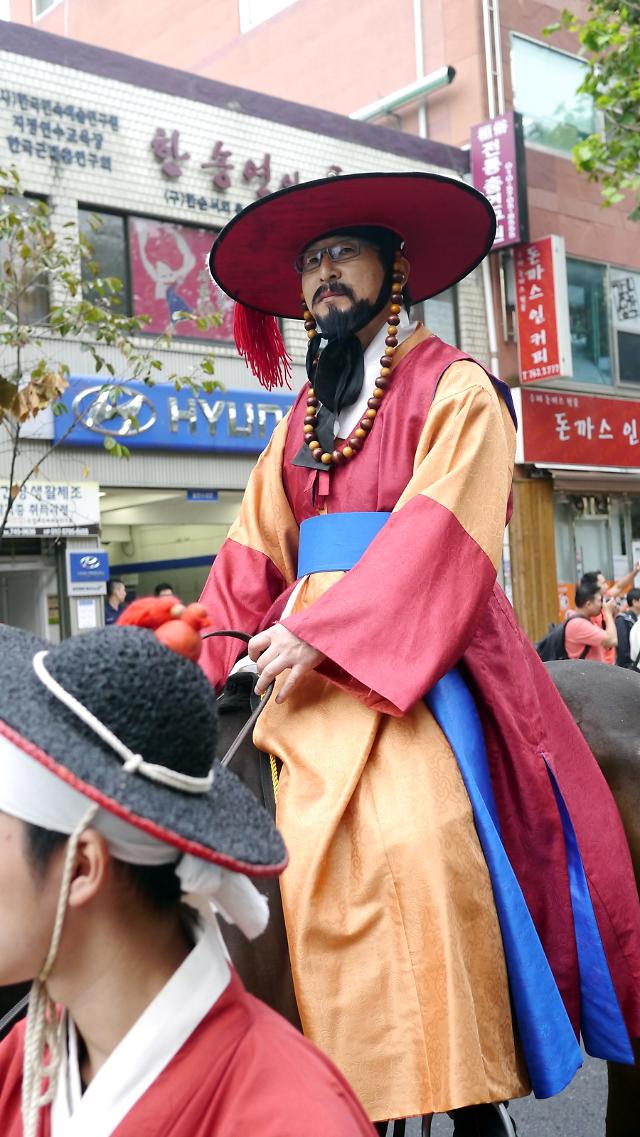
A volunteer acting as a Joseon Dynasty honor guard rides a horse during a royal parade in Seoul. [Photo by Park Sae-jin] [Photo by Park Sae-jin]
"I volunteered to take part in the parade because horse riding is my hobby, and I feel good to roam about the city on horseback," said Lee Seung-ho, a 43-year-old businessman who acted as a royal horseman.
Some 900 people wearing traditional costumes and 120 horses formed the initial relay that stopped in a riverside park to cross a bridge comprised of wooden boats into a small island in the middle of the Han River that runs through Seoul.
On the island, Seoul city mayor Park Won-soon, seen as a potential candidate in next year's presidential election, was dressed up in a robe to chair a ceremony, followed by the recreation of traditional markets and exhibitions.
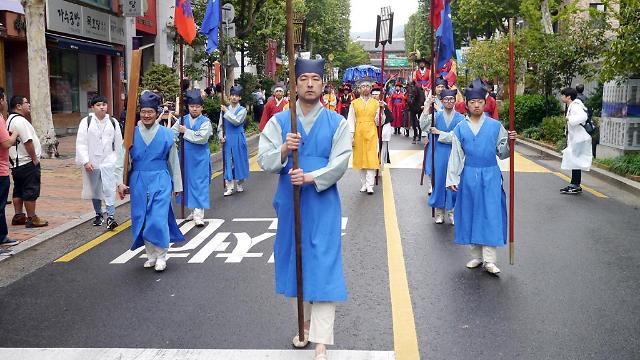
Participants dressed up as royal servants follow a long parade reenacted in Seoul. [Photo by Park Sae-jin]
At each rally point, old rituals and cultural performances were held. And the procession is to end Sunday evening in Hwaseong with a lantern festival, martial arts performances, and an evening military exercise in the fortress.
Along with King Sejong who invented the Korean alphabet, Jeongjo is recounted and respected by many Koreans as one of the greatest and visionary monarchies in the feudal kingdom of Joseon. Jeongjo achieved a cultural and industrial renaissance to reform the kingdom and improve the livelihoods of his people.
Performances to commemorate Jeongjo's passion and love of grass roots were arranged. When actors dressed up as poor peasants rush against the king asking for help, Jeongjo, played by a Seoul citizen, personally sets out to listen.

Reenactors await an order to join a royal parade in Seoul. [Photo by Park Sae-jin]
In Suwon, which used to be a walled city, the parade hands out rice grain packs to onlookers to reenact the scene of Jeongjo distributing rice to poor farmers.
Throughout his monarchy, the king was under the constant threat of assassination from opposing courtiers. Two assassination attempts will be revived with assassins appearing among onlookers for a street fight with royal palace guards.
Some experts see Jeongjo's strong leadership as a reflection of his childhood experience. His father Sado Seja, then the crown prince, was deposed by his own father, King Yeongjo, and was confined to a rice chest where he starved to death at the age of 28. The filicide has often become the subject of many TV dramas and movies in South Korea.
Aju News Lim Chang-won and Park Sae-jin


![[SUMMIT] Moon and Kim share car parade in Pyongyang](https://image.ajunews.com/content/image/2018/09/18/20180918133715829937.jpg)
